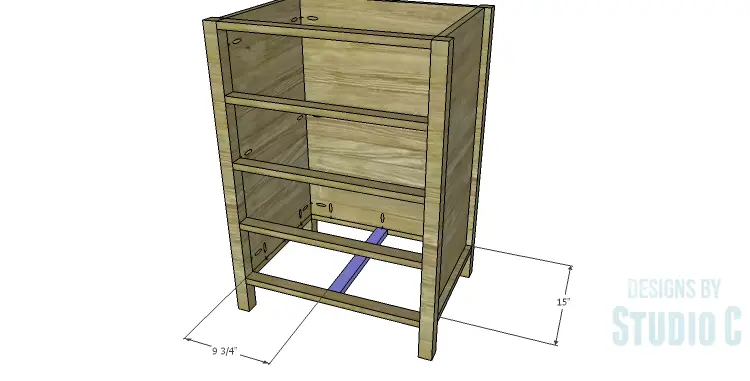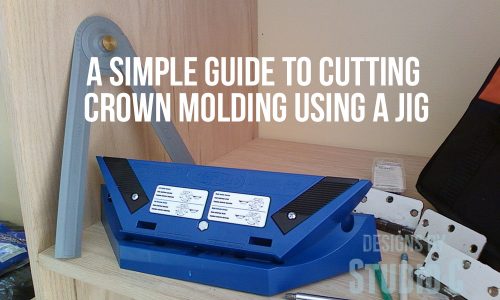A Fabulous Cabinet with Lots of Storage!
Hey there! It seems like everyone needs furniture with storage these days, right? Well, we’ve got some good news for you! Our DIY plans for the Matteo Drawer Cabinet can help solve your storage problems! This cabinet has six drawers (four small and two large) and is the perfect height. Plus, it’s narrow so it won’t take up too much space. Happy building!

Materials:
- 1-1/4″ pocket hole screws (<– affiliate link!)
- 1-1/4″ brad nails
- Edge banding, optional
- 6 sets of 14″ Drawer slides
- Cabinet pulls
- Wood glue
- Sandpaper (100, 150, 220 grits)
- Finishing supplies (primer & paint, or stain, sealer)
Lumber:
- 2 – 1×2 at 8′ (these pieces can also be cut from plywood)
- 4 – 1×6 at 8′
- 2 – 2×2 at 6′ (these pieces can also be cut from plywood)
- 1 – 4′ x 4′ sheet of 3/4″ plywood
- 1 – 4′ x 8′ sheet of 3/4″ plywood
Cut List:
- 4 – 2×2 at 33-3/4″ – Legs
- 2 – 1×2 at 15″ – Side Framing
- 2 – 3/4″ plywood at 15″ x 29″ – Side Panels
- 1 – 1×2 at 21″ – Back Framing
- 1 – 3/4″ plywood at 21″ x 29″ – Back Panel
- 5 – 1×2 at 21″ – Front Stretchers
- 1 – 1×2 at 15″ – Lower Stretcher Support
- 1 – 3/4″ plywood at 18″ x 24″ – Top
- 4 – 3/4″ plywood at 7-5/8″ x 12-1/2″ – Smaller Drawer Box Bottom
- 8 – 1×6 at 12-1/2″ – Smaller Drawer Box Sides
- 8 – 1×6 at 9-1/8″ – Smaller Drawer Fronts
- 2 – 3/4″ plywood at 12-1/2″ x 18-1/2″ – Larger Drawer Box Bottom
- 4 – 1×6 at 12-1/2″ – Larger Drawer Box Sides
- 4 – 1×6 at 20″ – Larger Drawer Box Front & Back
- 4 – 3/4″ plywood at 6-1/4″ x 9-7/8″ – Smaller Drawer Fronts
- 2 – 3/4″ plywood at 6-1/4″ x 20-3/4″ – Larger Drawer Fronts

Step One
Edge banding will be applied to the exposed edges of the plywood prior to assembly.
Cut the pieces for the legs, the side framing, and the side panels. With the pocket hole jig set for 3/4″ material, drill pocket holes in each end of the framing pieces as well as the side and bottom edges of the panels. Secure the framing pieces to the legs using glue and 1-1/4″ pocket hole screws. Orient the pocket holes so they face down and will not have to be filled.
Secure the panels to the legs and framing piece using glue and 1-1/4″ pocket hole screws. The back face of the panel will be flush with the inside faces of the legs and framing pieces.

Step Two
Cut the pieces for the back framing and the back panel. Drill pocket holes in each end of the framing piece as well as the side and bottom edges of the panel. Secure the framing piece to the legs using glue and 1-1/4″ pocket hole screws. Orient the pocket holes so they face down and will not have to be filled.
Secure the panel to the legs and framing piece using glue and 1-1/4″ pocket hole screws. The back face of the panel will be flush with the inside faces of the legs and framing piece.

Step Three
Cut the pieces for the front stretchers and drill pocket holes in each end. Orient the stretchers , except for the uppermost stretcher, so that the pocket holes face down. The pocket holes for the uppermost stretcher will face up and will be hidden by the top.

Step Four
Cut the piece for the lower stretcher support and drill pocket holes in each end. Secure the support to the lower front stretcher and the back framing piece using glue and 1-1/4″ pocket hole screws.

Step Five
Cut the pieces for the dividers and cut the notches using a jigsaw. Drill pocket holes in the back edge of each divider piece. Position the divider as shown securing in place using glue and 1-1/4″ pocket hole screws. Add a few brad nails through the front stretchers into the dividers to secure the front.


Step Six
Cut the piece for the top. Secure the top in place using glue and 1-1/4″ brad nails.

Step Seven
Cut the pieces for the drawer boxes. Drill pocket holes in all four edges of the bottom as well as each end of the sides. Assemble the drawer boxes as shown using glue and 1-1/4” pocket hole screws. Install the drawer slides according to the manufacturer’s installation instructions, locating them ¾” back from the front edge of the legs. Take a look at this easy tutorial on installing drawer slides! Make any necessary adjustments.




Step Eight
Cut the pieces for the drawer fronts. Mark the position for the drawer pulls and drill the holes. Shim the drawer front in the opening – there will be a 1/8” gap around all sides – then drive screws through the holes for the drawer pulls into the drawer box. Open the drawer, and secure the drawer front using countersunk 1-1/4” screws from the inside. Remove the screws from the holes for the drawer pull then finish drilling the holes. Install the drawer pull. This easy tutorial on installing drawer fronts will be helpful!

Finish as desired.
This cabinet would be an excellent addition to a bedroom as a small dresser or as storage in a bathroom. It would look great in any finish especially in a dark stain with a large stenciled design on the front! Leave a comment below if there are any questions about the DIY plans to build a Matteo Drawer Cabinet.
Originally posted 2014-12-22 08:00:28.






Comments are closed.